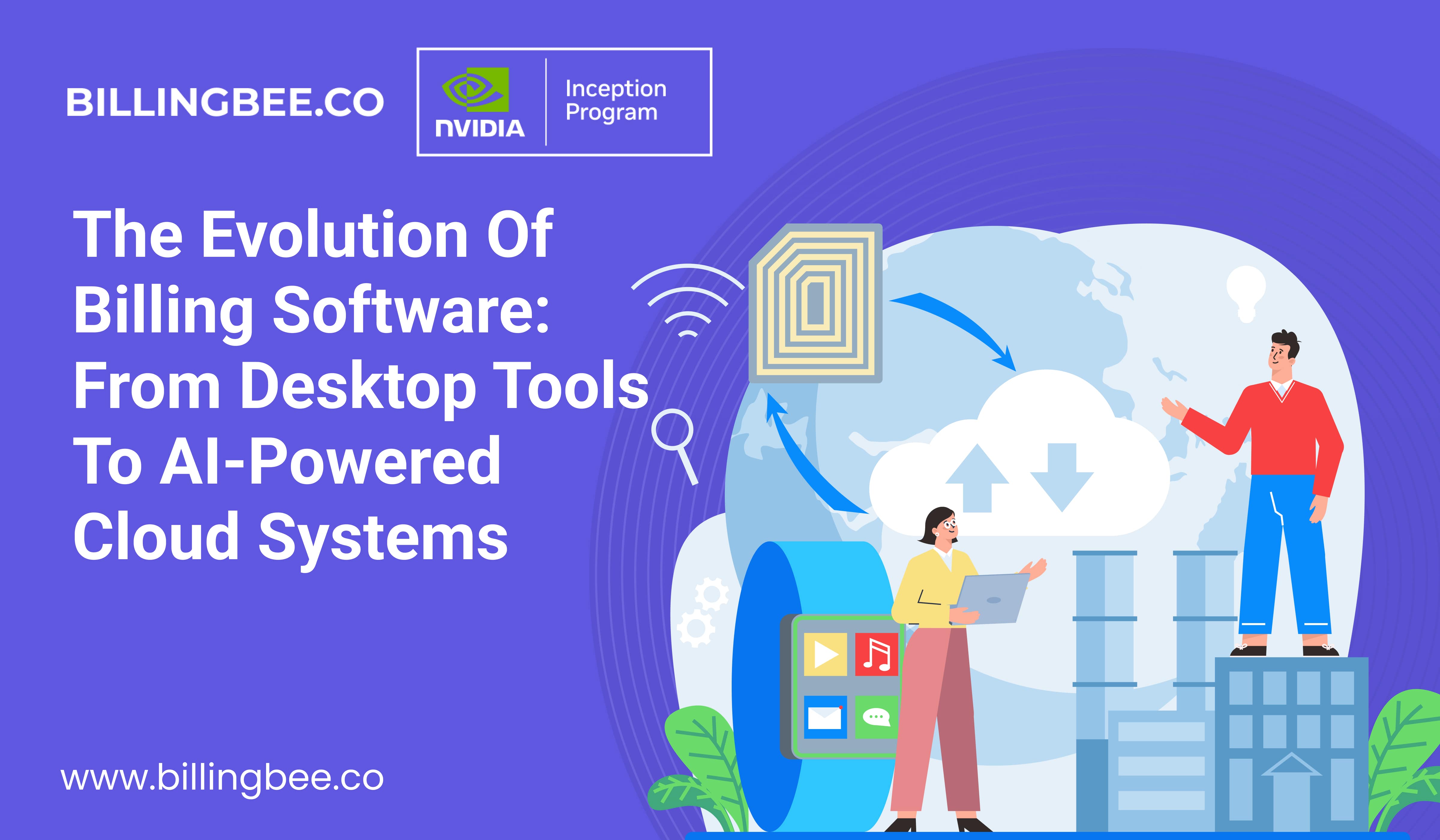The Evolution of Billing Software: From Desktop Tools to AI-Powered Cloud Systems




Billing software has come a long way — from bulky spreadsheets and desktop applications to intelligent, cloud-based systems that think, learn, and automate on behalf of businesses. What once took hours of manual entry and verification now happens in seconds, with AI ensuring accuracy, speed, and financial insight.
This transformation isn’t just about technology — it’s about how modern businesses work, collaborate, and scale. Let’s explore how billing software evolved through each major era, shaping the future of business operations.
1. The Beginning: Manual Billing and Early Desktop Tools
Before the digital revolution, billing was entirely manual. Businesses relied on paper invoices, handwritten ledgers, and manual calculations — a process prone to errors and inefficiencies.
Then came the desktop billing software of the late 1980s and 1990s. These tools, often built as standalone applications, allowed users to generate invoices, manage client data, and record transactions digitally. Programs like QuickBooks and Tally brought a revolutionary shift — eliminating paper trails and enabling faster billing.
However, desktop tools had clear limitations:
- Data was stored locally and prone to loss.
- Updates required manual installation.
- Collaboration across teams or devices was nearly impossible.
The need for accessibility, automation, and real-time data gave rise to the next big leap — the cloud.
2. The Cloud Revolution: Billing Goes Online
The 2000s marked a massive turning point — businesses started moving their operations online. Cloud computing emerged, changing how companies handled financial data and customer transactions.
Cloud-based billing software became a game-changer. Instead of saving data on one device, businesses could now access invoices, reports, and client details from anywhere. For the first time, billing systems became global — supporting remote teams, freelancers, and multi-branch organizations.
The major advantages were undeniable:
- Accessibility: Work from any location or device.
- Security: Data backup and encryption reduced the risk of loss.
- Scalability: Cloud systems could grow as the business expanded.
- Integration: APIs allow seamless connections with CRMs, payment gateways, and accounting software.
Tools like BillingBee, FreshBooks, and Zoho Books redefined what billing meant — simple, fast, and online. But the next leap was yet to come.
3. The Automation Era: Smart Billing Takes the Stage
As businesses handled increasing volumes of transactions, automation became the natural next step. Automated billing software started using rule-based engines to:
- Generate recurring invoices automatically.
- Send payment reminders.
- Track overdue payments.
- Reconcile accounts in real time.
Automation turned billing into a self-operating system. Instead of spending hours on repetitive data entry, finance teams could now focus on strategy and analysis.
Yet, automation was still limited by logic — it could follow instructions, but not learn or predict. That’s where AI-powered billing software changed everything.
4. The AI Revolution: When Billing Software Got Smarter
Artificial Intelligence brought intelligence and intuition to billing. Today, AI-powered billing software doesn’t just process data — it interprets it.
Here’s how AI is redefining modern billing systems:
1. Predictive Analytics
AI algorithms forecast cash flow, predict late payments, and analyze spending patterns. This helps businesses take proactive actions rather than reactive ones.
2. Error Detection & Fraud Prevention
AI automatically scans transactions for inconsistencies, potential duplicates, or fraudulent activity — saving time and protecting revenue.
3. Personalized Client Insights
AI learns from client history, allowing the system to tailor reminders, discounts, and follow-ups for different customers.
4. Voice & Chat Automation
Integrated virtual assistants now handle invoice queries or payment confirmations through chat or voice — making the billing process conversational and accessible.
5. Seamless Integration with AI Tools
Modern platforms like BillingBee are beginning to integrate AI with accounting, CRM, and project management tools — creating a unified ecosystem where every transaction tells a story.
5. The Cloud-AI Synergy: Billing Becomes Intelligent and Everywhere
The combination of cloud computing and AI is the most powerful duo in billing history. Together, they make billing not only smarter but also borderless.
- AI + Cloud = Real-Time Decision Making
Businesses can instantly analyze global transactions, detect anomalies, and predict revenue trends. - AI + Automation = Time Savings
Invoices are generated, verified, and sent automatically — with zero manual effort. - AI + Personalization = Customer Loyalty
AI-driven insights allow personalized communication and reward programs that improve client retention.
This synergy is what defines today’s billing software landscape. It’s not just about sending invoices — it’s about empowering businesses to make better financial decisions through data-driven intelligence.
6. What’s Next: The Future of Billing Software
As technology continues to evolve, so will billing systems. The next frontier may include:
- Blockchain Billing for transparent, tamper-proof transactions.
- Voice-Based Invoicing, where commands replace clicks.
- Augmented Reality Dashboards for real-time financial visualization.
- Global Currency AI Management that auto-adjusts pricing and tax compliance for international clients.
Tomorrow’s billing software won’t just manage money — it will manage business growth.
7. Why This Evolution Matters
Every shift in billing software history represents a step toward freedom — freedom from errors, manual work, and limited access.
For small businesses and freelancers, it means more time to focus on creativity and clients. For enterprises, it means more control, transparency, and predictive power.
Platforms like BillingBee embody this evolution — helping users experience the next generation of billing: automated, cloud-connected, and AI-enhanced.
Final Thoughts
From ledgers and desktop tools to AI-powered billing software, the journey reflects how far business technology has come. Billing is no longer just about money management — it’s about empowerment, insight, and innovation.
The next time you send an invoice through a cloud-based billing tool, remember: you’re using decades of evolution, innovation, and intelligence — all wrapped into one click.